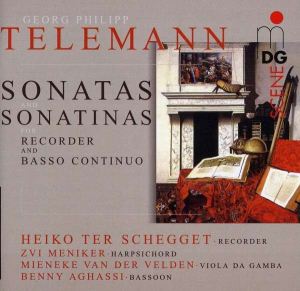 |
 |
|


alternatively
CD: MDT
AmazonUK
AmazonUS
|
Georg Philipp TELEMANN (1681
- 1767)
Sonatina in c minor (TWV 41,c2) [8:35]
Sonata in C (TWV 41,C5) [7:59]
Sonatina in a minor (TWV 41,a4) [8:50]
Sonata in B flat (TWV 41,B3) [6:43]
Sonata in d minor (TWV 41,d4) [9:35]
Sonata in f minor (TWV 41,f1) [11:11]
Sonata in C (TWV 41,C2) [7:42]
Sonata in F (TWV 41,F2) [6:10]
 Heiko ter Schegget (recorder), Mieneke van der Velden (viola da
gamba), Benny Aghassi (bassoon), Zvi Meniker (harpsichord)
Heiko ter Schegget (recorder), Mieneke van der Velden (viola da
gamba), Benny Aghassi (bassoon), Zvi Meniker (harpsichord)
rec. 21-23 June 2010, the former Ackerhaus of Marienmünster
Abbey.
 MUSIKPRODUKTION DABRINGHAUS UND GRIMM MDG 905 1693-2 [67:31]
MUSIKPRODUKTION DABRINGHAUS UND GRIMM MDG 905 1693-2 [67:31]
|
|
|
Georg Philipp Telemann is quite popular among recorder players.
More than any other composer of the German baroque he has provided
them with fine music to play. The recorder is often included
in the scoring of cantatas, oratorios and orchestral overtures.
More importantly, his chamber music oeuvre includes a considerable
number of pieces which are either specifically written for or
at least playable on the recorder. This instrument was mostly
played by amateurs, and this explains why many pieces appear
in collections which were intended for the growing market of
amateur musicians.
Telemann not only had a good nose for the fashion of his time,
he was also a clever businessman. In 1728 he launched a periodical,
called Der getreue Music-Meister.It included pieces of
all kinds and in all sorts of scorings: opera arias, harpsichord
pieces, canons and solo sonatas. If music-lovers wanted to have
complete sonatas they had to subscribe as he split multi-movement
pieces across various issues. A good example is the Sonata
in f minor whose four movements were divided over four issues.
Today this is one of Telemann's most popular works, scored for
bassoon and bc, but also playable on the recorder. In particular
in collections like this most pieces can be played on various
instruments, even if that is not specifically indicated by the
composer.
Therefore there is no objection to the scoring of the Sonata
in B flat here. In Der getreue Music-Meister Telemann
himself had offered various alternatives: viola da gamba and
bc or several combinations without basso continuo, like recorder
and viola da gamba, and even a transposition to A major for
the scoring of transverse flute or violin and viola da gamba
without basso continuo. Here it is played with recorder, bassoon
and bc. It is a strict canon; the second instrument enters at
various moments during the sonata.
Another important collection of solo sonatas and trios is Essercizii
musici which until recently was considered a rather late
work, dating from 1740. In his liner notes Telemann scholar
Steven Zohn states that they were likely written around 1727.
This earlier date allows him to conclude that Telemann ceased
composing anything specifically for the recorder after 1733,
reflecting the vanishing popularity of the instrument. The Essercizii
musici include no fewer than six pieces for recorder and
bc or trios for recorder and a second instrument plus basso
continuo. For this recording two of these have been chosen:
the Solo 4, in the track-list Sonata in d minor,
and the Solo 10, or Sonata in C (TWV 41,C5). The
latter has only three movements, but the first of them comprises
four sections: adagio-allegro-adagio-allegro. The Sonata
in d minor (erroneously catalogued as d2 in the track-list)
shows that Telemann's music is certainly not devoid of serious
expression, as is particularly to the fore in the opening affettuoso.
The same is true of the above-mentioned Sonata in f minor,
whose opening movement has the indication triste.
Two of the pieces are called sonatina. They are from
a collection of six Nouvelles sonatines which dates from
1730/31. Four of them are scored for violin or transverse flute,
the sonatinas 2 and 5 for recorder. The problem with this set
is that only the partbooks for the melody instrument have been
preserved; the basso continuo part has disappeared. In the 1990s
the bass parts of the two sonatinas for recorder were rediscovered
in the Dresden court music collection. This is an indication
that, although Telemann's chamber works were intended for amateurs,
professional players considered them good enough to add to their
repertoire. The discovery of these basso continuo parts not
only opens the door to performance of these two pieces, it also
contributes to our knowledge about the reception of Telemann's
music.
Some of the pieces on this disc are fairly well-known, but the
sonatinas are new to the catalogue - as far as I know - and
some are performed in a different scoring than usual. Heiko
ter Schegget and his colleagues provide very fine performances,
lively and passionate in the fast movements, and with sensitivity
in the slow movements. Ter Schegget plays two different recorders:
his own copy of a Jacob Denner, which in his view has a more
Italian character, whereas the other, by Johann Heytz of around
1725 is more French in sound. Interestingly he uses the original
instrument from the collection of Frans Brüggen. It has
some deficits; in the liner-notes Ter Schegget writes that he
has used some technical tricks to overcome them. Only in the
fast movements was that not possible. Here he has turned to
his own copy of this instrument. Even so, this instrument is
a beauty to hear, and the use of an original instrument is a
bonus.
One doesn't need to be a recorder buff to love this disc.
Johan van Veen
http://www.musica-dei-donum.org
https://twitter.com/johanvanveen
|
|

